2018
Kgopotso Magoro establishes the Zuri Foundation.
Kgopotso Magoro and the Internet Society’s South Africa Gauteng Chapter run a community workshop on the potential of community networks and connecting the unconnected.
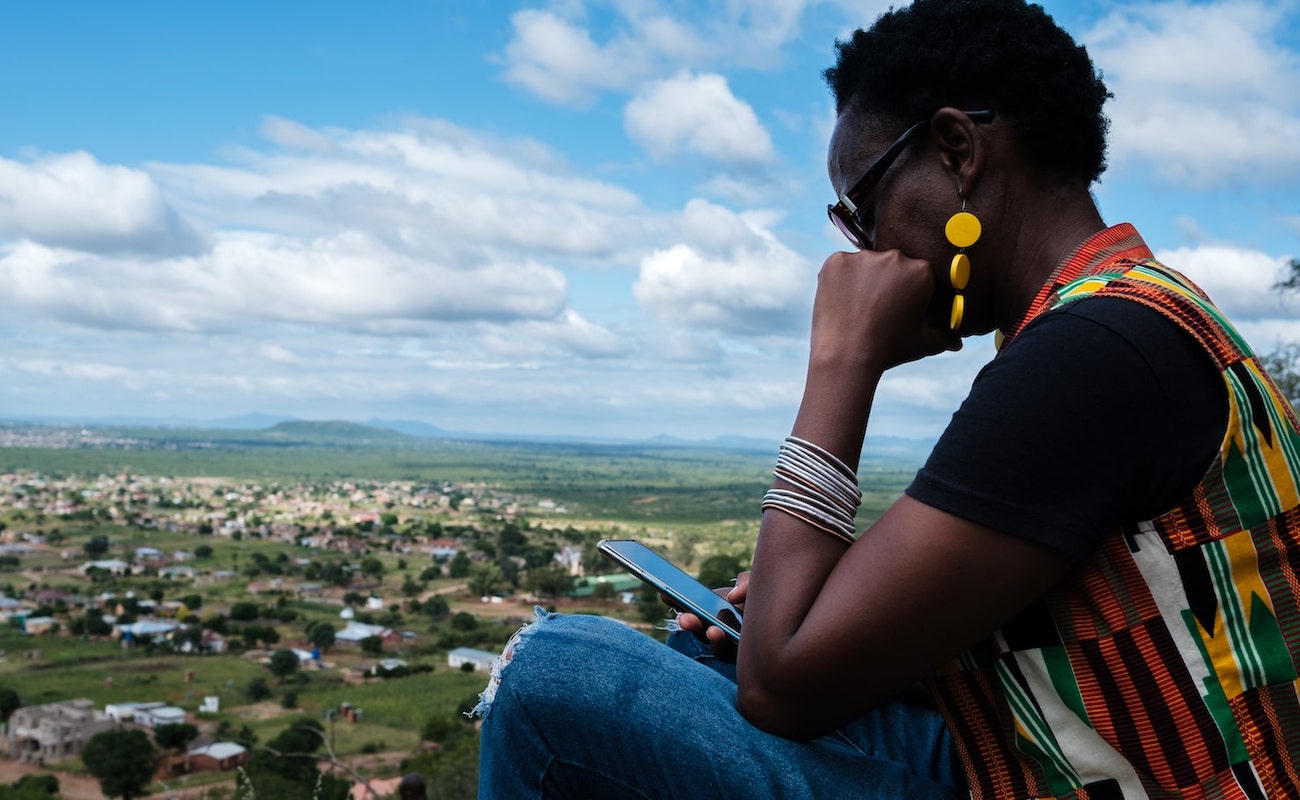
In the opinion piece, Hlokomelo Mabogale, a South African chicken farmer and digital activist, wrote about the disadvantages rural youth experience by lack of access to quality education, computers, and the Internet. Being from a rural area himself—Mamaila in the country’s northernmost Limpopo province—it was an issue he knew all too well. Remembering his own lack of digital skills as a young person, Mabogale signed off with a plea, “These days, Internet is life.”
It resonated with Kgopotso Magoro, a civil servant and PhD student who also grew up in Mamaila. Like many from the area, she had moved away to the cities of Johannesburg and Pretoria for the sake of her education and employment prospects. Reading Mabogale’s words, she felt compelled to act. So began the long journey that eventually led to the Mamaila Community Network.
Mamaila is a cluster of six villages in the Greater Letaba Municipality, made up of more than 20,000 people. In South Africa there are striking rural-urban inequalities, both socioeconomic and in terms of the digital divide. Mamaila is no exception. According to government statistics for the parent municipality, over fifty percent of the population are not economically active and only twenty-two percent are employed. Farming is the primary economic activity, though a significant proportion of households depend on social grants and casual wage labor.
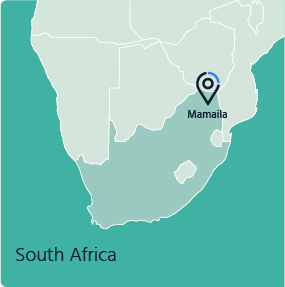
Hlokomelo Mabogale, a digital connectivity activist and entrepreneur, taking his daughter and neighbors
to their preschool in their home village of Mamaila Kolobetona.
Fifty-five percent of households are headed by women—a result of economic migration and South Africa’s challenging history with HIV. Between gender-based income disparities, fewer employment opportunities for women, and other factors, these households are generally poorer, with average annual household income in the region at ZAR 14,600 (US$926). On a positive note, small businesses are growing. A shopping mall is also under construction—the area’s first—bringing hope to the community that it will foster economic growth.
The technology landscape is just as stark, with Internet access out of reach for most residents. The area is served by several mobile providers, but coverage is expensive and unreliable. One gigabyte of data ranges in price from roughly ZAR 30 (US$2) for 24 hours to ZAR 85 (US$5.75) for 30 days. Even this is cost prohibitive for many, where a loaf of bread, a kilo of rice, or a liter of milk cost around ZAR 15 (US$1), and most users purchase data in smaller increments, which come at an even higher price per megabyte. There is a commercial Internet service provider active in the area, but at ZAR 290 (US$19) per month for an uncapped 3Mbps connection, plus an installation fee of ZAR 2,500 ($170), it is unaffordable for the vast majority of the area’s residents.
Buy data, or buy bread? You have to think twice.”
Mamaila is “a deep-rooted rural area,” says Dr. Peter Mamaila, secretary of the Mamaila Royal council and Bishop of Moratabatho Missionary Church International. But, he adds, “it is a rural area, it is not an island. It is still connected to South Africa. So much as the other parts of South Africa advanced technologically, we ought to be part.” Like many of his fellow residents, he feels that the connectivity gap holds back the youth, especially in terms of education, employment opportunities, access to information, and the chance to innovate. Hlokomelo Mabogale tries to help as best he can. He lets young people in his neighborhood use his home Internet connection for free, so they can research school projects or apply for jobs online.
Rapeulane “Lebeko” Kamogelo embodies the challenges young people face when it comes to connectivity, and the potential of being connected to offers. Needing something to occupy her mind as she struggled with the death of her father, she taught herself to crochet from YouTube videos. She was away at university, where connectivity was good and affordable. When she returned to her home village of Sephukubje after graduation, people saw the clothes she’d made and asked her to crotchet pieces for them and her pastime soon became an income stream.
Social media has become her lifeline as she posts her work online and receives orders from around the country. But she cannot afford Wi-Fi, struggles with poor mobile data connectivity, and must spend at least ZAR 200 (US$13) per month to reach her customers. She feels it’s holding her back. If she could afford more data, she could grow her business even more.
“We [young people] have got so many great ideas, but since we can’t access Internet and the data is too expensive, some of us can’t reach our goals.”
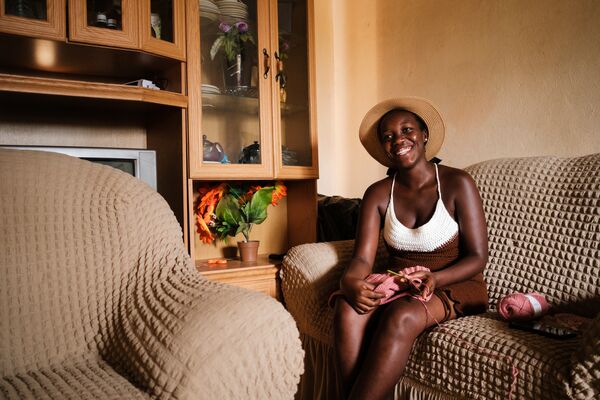
Lebeko Kampgelo crocheting a dress at her home in Sephukubje in the Limpopo province of South Africa.
The COVID-19 pandemic has sharpened what it means to be under-connected. With the exception of a few schools that have low-bandwidth connections for teachers, the area’s thirteen schools are offline. This is “a struggle,” says Neo Magoro. She’s the project manager for the Zuri Foundation and the Mamaila Community Network, and responsible for the network’s implementation. “People were not able to access school material during the lockdown. During the phase where schools were closed, it meant that there was no school—you are sitting at home, you can’t catch up on your homework…all that information is available on the Internet, but if you don’t have enough data for that or you have poor connection, it is useless.”
Kgopotso Magoro touched a computer for the first time when she was 19 years old. She had just left Mamaila and, on a whim, decided to take a computer course in the gap between high school and university. It was 1996. Like Mabogale, Magoro remembers the challenges of competing at university with peers who had grown up with computers. “I’m coming from a village. I’m meeting people from Johannesburg who’ve been exposed to computers. I was studying with my cousin. We were just like, ‘OK, so this is a computer…’ For three months I didn’t have the confidence to use one.” She thinks these early experiences were the root of her desire to bring positive change through technology.
Magoro began teaching herself web development and content management skills online, then sought out professional opportunities so she could put these skills to use. She pursued a master’s, focusing on the problem of rural connectivity. For her ongoing PhD research, she decided to focus on solutions.
It had been her experience that “the Internet can transform your life,” and she felt a growing need to share this revelation with others. Not long after she read Mabogale’s article in 2017, she won a fellowship from the Internet Society’s South Africa Gauteng Chapter. At the end of the fellowship, participants were asked to put what they had learned into practice. Taking the request to heart, she returned to Mamaila to run a workshop on community networks and connecting the unconnected. “Everybody was inspired,” she says. The seeds for the Mamaila Community Network were sown.
Someone had to come in and change something. It happened to be us.”
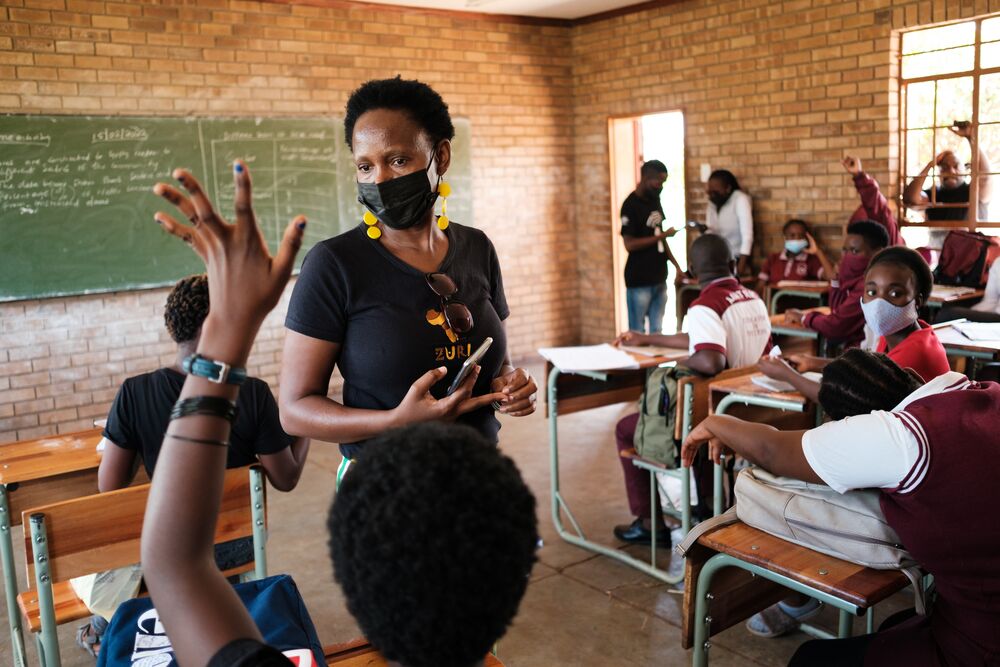
Kgopotso Magoro, founder of the Mamaila Community Network with grade 11 students at Mathibadifate Secondary School in Mamaila.
Magoro’s first step was to establish the Zuri Foundation, with the aim of “bridging the gap between human aspiration, technology, and culture by developing community telecommunications infrastructure.” She applied for a license to operate a community network from the Independent Communications Authority of South Africa (ICASA), then set about to find a connectivity partner. She appealed to mobile operators and ISPs active in the area, hoping one would take on the project in the spirit of corporate-social responsibility, but met with little success. Just as she began to despair, a chance introduction led her to Pardon Mabunda, CEO of the Kichose Group of Companies, which offers a range of retail connectivity products. Mabunda leapt at what he saw as “an opportunity to do the right thing.”
Using her own savings and a donation from her mother, Magoro and Mabunda established a pilot network with a budget of ZAR 55,000 (US$3,700). Using a radio colocated on a nearby mobile operator’s tower, they were able to offer 20 Mbps links to three hotspots in the community. Access was free.
The pilot was successful, but disaster struck less than three months in. The network went down when the equipment fell victim to the power surges that are a common side-effect of the nation’s power sector troubles. Magoro had already drawn down her savings to prove the community network concept—and there was no more money to try again.
The project was given a lifeline with a US$30,000 Beyond the Net grant from the Internet Society Foundation, which the Internet Society’s South Africa Gauteng Chapter applied for on behalf of the project. Rather than replace or repair the damaged equipment, the team decided to implement a more lasting solution.
Pardon Mabunda (left) and Stephan Jacobs on a tower belonging to the Mamaila Community Network, preparing to install additional batteries to improve the tower’s reliability.
The Zuri Foundation and Kichose Technology had a vision: a network covering the six villages of Mamaila. The network would have its own tower to eliminate dependence on a mobile operator’s infrastructure and to make it possible to switch providers in the future if necessary.
Yet, setting up a community network does not come without challenges and Magoro soon found herself facing the reality. “Connecting the unconnected sounds like a nice thing when we are in a webinar, but on the ground it is a different story,” she says.
There was a major setback right at the start. The Beyond the Net grant funds had been paid out to the Internet Society’s South Africa Gauteng Chapter, but when it was time to implement, there were delays and lack of transparency from the chapter. The Internet Society launched an investigation and found evidence that the funds were spent on things other than intended. The chapter was suspended, but it left the Zuri Foundation in a bind. They had set expectations and timelines for the community, but lacked the resources to follow through. Fortunately, the Internet Society Foundation believed in the project, and provided a grant directly to the Zuri Foundation for a community network.
With funding in place, the project next had to find a suitable site for the tower, which presented its own challenges. The Mamaila Royal Council had allocated a seemingly ideal plot of land to the project, next to the main road that runs through the village of Roerfontein—the economic hub of the area. However, the location needed a 30-meter tower to establish lines of sight with all of the targeted villages, and getting permission to build was complicated even more by the site’s proximity to the road and residential dwellings. Instead, the project found a new site—on a hillside with clear lines of sight to all six villages. Even better, this location would only require an 18-meter tower. The drawback: the three six-meter sections of the tower had to be hauled up the hill on foot by community members with the help of ropes. The tower was completed in February 2021, but due to financial issues further work had to wait.
Work restarted a few months later in August. Pardon Mabunda of the Kichose Group and his team climbed up the hill to connect the tower to the Internet, where they found the next setback waiting. Early on, the project had decided to power the radios on the tower with solar panels and batteries. This would address the challenges of providing electricity to the tower and the unreliability of the national grid. But once on the hill, Mabunda and his team found the equipment cabinet vandalized and the solar panels and batteries stolen. The project had to replace the costly equipment and add yet another expense: anti-theft measures. The power is now mounted in a cabinet several meters up the tower, with CCTV in place and a motion-activated floodlight visible to the village below. It set the project back a further month. Ironically, when the team was ready to bring the tower online, they found themselves unable to communicate with their connectivity partner. The partner’s tower had also been targeted by thieves.
After this last challenge was resolved, the project made a last-minute decision to increase the community network tower’s solar and battery capacity to ensure round-the-clock availability: “You don’t want people to buy data bundles”, says Magoro, “and then the quality is not good.”
The tower is now online. The first six hotspots are up and running, and users are beginning to purchase vouchers and get online as word spreads. There’s a plan to add more hotspots.
The community network’s tower is connected to the wider Internet via a wireless link to a tower operated by national telco MTN, which in turn connects to a fiber network operated by Teraco Data Environments and CMC Networks.
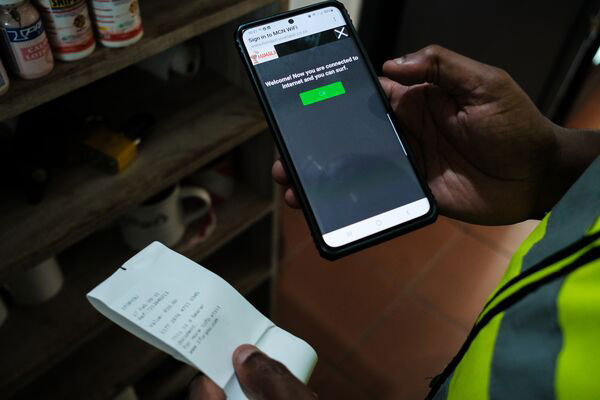
Pardon Mabunda, CEO of Kichose Technology, technical partner of the Mamaila Community Network, testing the network connection after setting up the network’s first end user hotspot at the Galito’s fast food restaurant in the village of Roerfontein .
So far, six hotspots in two villages have been established, and there are plans to extend to the remaining villages. Point-to-point wireless links from the community network’s tower will provide connectivity to hotspots in the six villages under the tribal authority, over distances of up to about eight kilometers. Based on pilot learnings, the project selected radios that are better able to withstand the area’s high summer temperatures.
Each hotspot has an estimated capacity of up to 200 simultaneous end-user connections. Data will initially be sold in 1Gb increments, valid for 24 hours, at roughly one third the cost of comparable packages from mobile operators. The current forecast is that the network can break even with thirty 1Gb purchases per hotspot, per day.
To eliminate the need to deal with cash, the community network chose to use the 1ForYou voucher platform. The vouchers are in wide use nationally and familiar to the community, and they can be bought in local shops and online. It’s also beneficial in a region affected by migratory labor: breadwinners in the cities can purchase data for their children and families at home in the villages. Using the platform can also deliver insights into how the community is connecting. Its built-in reporting will provide visibility on sales and usage figures per hotspot.
Beyond financial viability, it was important that the community feel a sense of ownership of the network. To this end, an agreement was signed with the Mamaila Royal Council enshrining them as the custodians of the network. It’s seen as a culturally and locally appropriate solution. In Kgopotso Magoro’s words, “when we say we are in a partnership with the Royal Council it is not tokenism, it’s a real partnership and they also feel that they are part of it.” The council provided land for the tower and will play a role as arbiter in case there are any future conflicts over fair use of the network.
Under the terms agreed with the council, the Zuri Foundation is the implementing partner establishing the network on the council’s behalf. A project coordinator appointed by the council is to work with the Zuri Foundation’s project manager, providing an interface between the council and the network’s implementation and operation.
The Zuri Foundation has also taken pains to plan for the long-term viability and governance of the community network. A steering committee of elected representatives from each village is to represent the needs of their respective villages as they pertain to the network. They will also play awareness, training, and knowledge transfer roles, and identify both challenges and opportunities moving forward. They will be expected to ensure that the network is used in ways that benefit their communities.
As a complement to the community network, the Zuri Foundation is also establishing a solar learning lab—something of a “living lab,” Magoro hopes. Funded by Computer Aid International, it will be equipped with computers and serve as a hub for digital skills development, innovation, and experimentation. Echoing Dr. Peter Mamaila’s words—that Mamaila is not an island and still connected to South Africa—the Eastern Cape’s Zenzeleni Community Networks has stepped in to help, too. They provided support for the learning lab, including assessing the community needs and writing the lab manual.
The hope is that the network will eventually generate enough extra revenue so that a digital fund can be established. To be administered by Zuri Foundation and the Royal Council, it will provide scholarships to young people who want to pursue digital studies. It will change the perspective of rural youth and their opportunities in a digital world, lifting the curse Mabogale had written about all those years ago.
After setting up the first Wi-Fi access point at the fast-food restaurant, shop, and petrol station complex at the heart of the village of Roerfontein in mid-February 2022, Pardon Mabunda of Kichose Technology smiles as he watches a YouTube video on his phone, testing his handiwork. “I’m a happy man,” he says.
Rapeulane “Lebeko” Kamogelo, meanwhile, has posted a new crochet creation online. “Right now, due to the high unemployment rate in our country, young people like us have to create jobs. So how do we create jobs if we can’t expand our knowledge?” She hopes the Mamaila Community Network will help.
Restaurant manager Tshepo Confidence Masutha is excited, too. “I think a lot of people will come, this place will be a hot spot. We will get new customers, the business will be good.” He’s already thinking about additional outdoor seating.
These days, when Internet is life, Mamaila finally has a place at the table.
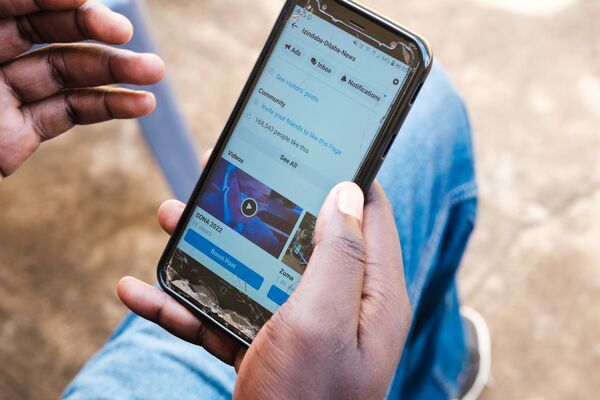
Hlokomelo Mabogale, a digital connectivity activist and entrepreneur, showing heavily subscribed Facebook pages he established as a platform to interact with his local community at his home in the village.
2018
Kgopotso Magoro establishes the Zuri Foundation.
Kgopotso Magoro and the Internet Society’s South Africa Gauteng Chapter run a community workshop on the potential of community networks and connecting the unconnected.
2019
The Zuri Foundation is granted a license to operate a community network by the Independent Communications Authority of South Africa (ICASA).
The Zuri Foundation partners with Kichose Technology and establishes a pilot network with three hot spots providing free Internet access.
A US$30,000 Internet Society Foundation Beyond the Net grant is approved through the Internet Society’s South Africa Gauteng Chapter.
2020
Delays occur due to financial malfeasance at the Internet Society’s South Africa Gauteng Chapter.
The Internet Society Foundation cancels the Beyond the Net grant.
2021
The Internet Society Foundation approves US$25,000 disbursement to the Zuri Foundation.
A network vision is developed by the Zuri Foundation and Kichose Technology.
A community network tower is erected by Kichose Technology.
Theft of equipment causes delays.
2022
Network base infrastructure is completed.
Launch of network, with initial six hotspots in two villages.
Acknowledgements: Sol Luca de Tena, Nicholas Eppel
Image copyright: © Nyani Quarmyne